Next: Bipolar Junction Transistor (BJT) Up: ch4 Previous: Semiconductor materials
A diode is formed by a PN-junction with the p side called anode and the n side called cathode. Due to the fact that there exist few freely movable charge carriers in the depletion region around the PN-junction, the conductivity is very poor. However, when external voltage is applied to the two ends of the material, the conductivity may change, depending one the polarity of the applied voltage.
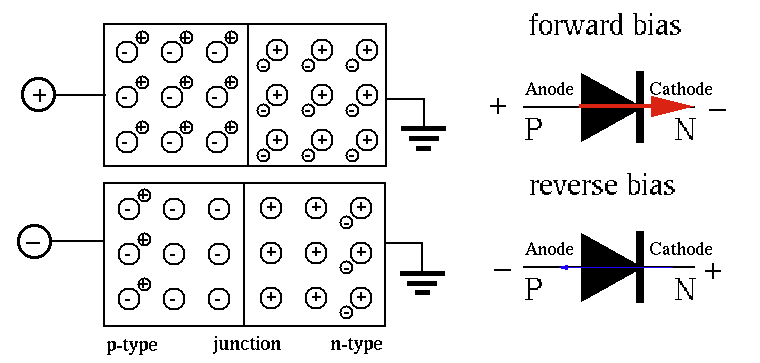
The positive voltage applied to the P-type will pull electrons in N-type and repel holes in P-type so that both carriers are moving towards the PN-junction. As the depletion region becomes thinner, the conductivity increases due to the drift current through the PN-junction from the P side to the N side, formed by the majority charge carriers (both electrons and holes) driven by the applied voltage. The conductivity increases as the applied voltage becomes higher.
The negative voltage applied to the P-type will repel electrons in N-type
and attract holes in P-type so that both carriers are moving away from
the PN-junction. As the depletion region becomes thicker than before,
there is no current through the PN-junction from the P side to the N side.
However, there exists a very small current 
 or or |
(2) |
 is the reverse saturation current, a tiny current that
flows in the reverse direction when
is the reverse saturation current, a tiny current that
flows in the reverse direction when  , due to the minority
carriers. As this current is limited by the minority carriers available,
when all of them are contributing to this current, higher voltage
, due to the minority
carriers. As this current is limited by the minority carriers available,
when all of them are contributing to this current, higher voltage  does not result in greater current, i.e., the current is saturated.
does not result in greater current, i.e., the current is saturated.
 is about
is about
 A for Si and
A for Si and  A for Ge.
A for Ge.
 is the thermal voltage, where
is the thermal voltage, where
 Joules/Kelvin is the
Boltzmann constant,
Joules/Kelvin is the
Boltzmann constant,
 coulomb is the charge of an electron, and
coulomb is the charge of an electron, and
 is the temperature in degree K. At room temperature
is the temperature in degree K. At room temperature  (
(
 ),
),
 .
.
 is the ideality factor which varies between 1 and 2, depending
on the fabrication process and semiconductor material. In many cases
is the ideality factor which varies between 1 and 2, depending
on the fabrication process and semiconductor material. In many cases  can be assumed to be approximately equal to 1.
can be assumed to be approximately equal to 1.
 ,
,
 ;
;
 ,
,  ;
;
 ,
,
 .
.
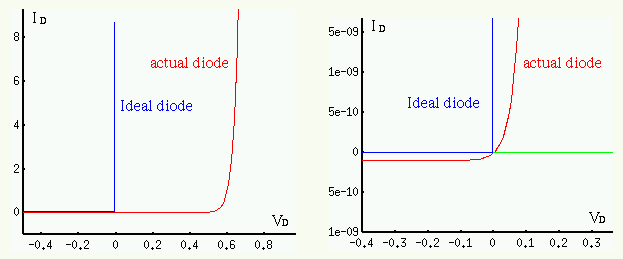
The voltage 


 |
(3) |
The resistance of an electrical device is defined as



 |
(4) |
 , i.e.,
, i.e.,
 . We assume
. We assume
 ,
,  , the resistance
of the diode is not a constant, but a function of the current
, the resistance
of the diode is not a constant, but a function of the current  , i.e.,
a diode is not a linear element:
, i.e.,
a diode is not a linear element:
 |
(5) |
Models of diodes:
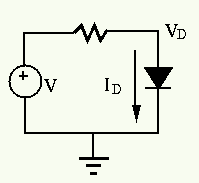
 ,
,
 ,
,  , else
, else  ,
,  .
.
 :
if
:
if  ,
,  , else
, else  ,
,

 :
if
:
if  , then
, then  , else
, else

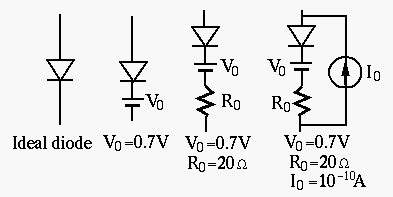
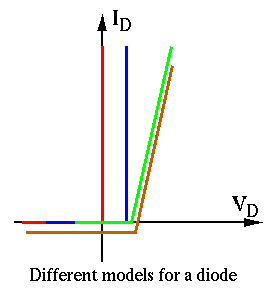
In general, when the forward voltage applied to a diode exceeds 0.6 to 0.7V for silicon (or 0.1 to 0.2 V for germanium) material, the diode is assumed to be conducting with low resistance.
Example: In the half-wave rectifier circuit shown below,






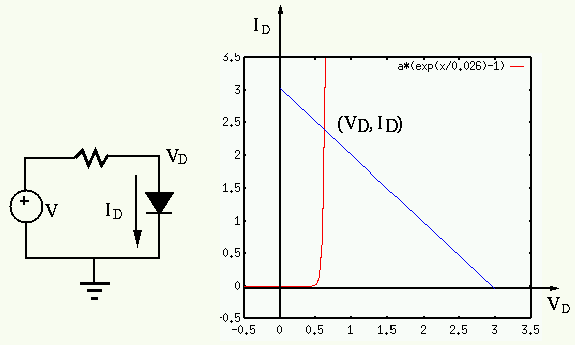
 .
.
 and the current can be determined
by Ohm's law to be
and the current can be determined
by Ohm's law to be
 .
.
 ,
,
 , and an ideal diode.
, and an ideal diode.
 ,
,
 .
.
 and voltage
and voltage  have to satisfy
two equations simultaneously:
have to satisfy
two equations simultaneously:
 |
(6) |
 through and voltage
through and voltage  across a diode, while the second is obtained by KVL. Substituting the first
equation into the second, we get
across a diode, while the second is obtained by KVL. Substituting the first
equation into the second, we get
 . Substituting
this into the first equation we can then find
. Substituting
this into the first equation we can then find  .
.
 is the
characteristic curve of the diode, while the second equation
is the
characteristic curve of the diode, while the second equation
 is the load line, a straight line passing through
is the load line, a straight line passing through
 and
and
 . The intersection point of the two curves is approximately
at
. The intersection point of the two curves is approximately
at
 .
.
Diodes are typically used as rectifiers which convert an AC voltage/current in to a DC one, such as shown in the following example.
Example 2: Design a converter (adaptor) that converts AC power
supply of 115V and 60 Hz to a DC voltage source of 14 V. When the load is

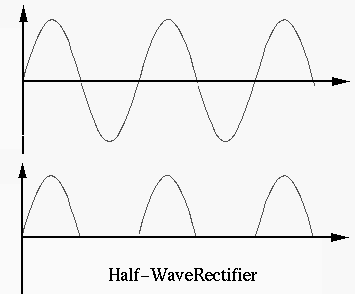

 with RMS value
with RMS value
 , the ratio
of the transformer should be
, the ratio
of the transformer should be
 .
.
 , the load current is approximately
, the load current is approximately
 .
.
 , the charge
on the capacitor is reduced by
, the charge
on the capacitor is reduced by
 .
.
 .
.
 , we get
, we get
 .
.
 |
(7) |
More diode rectification circuits are shown below:

